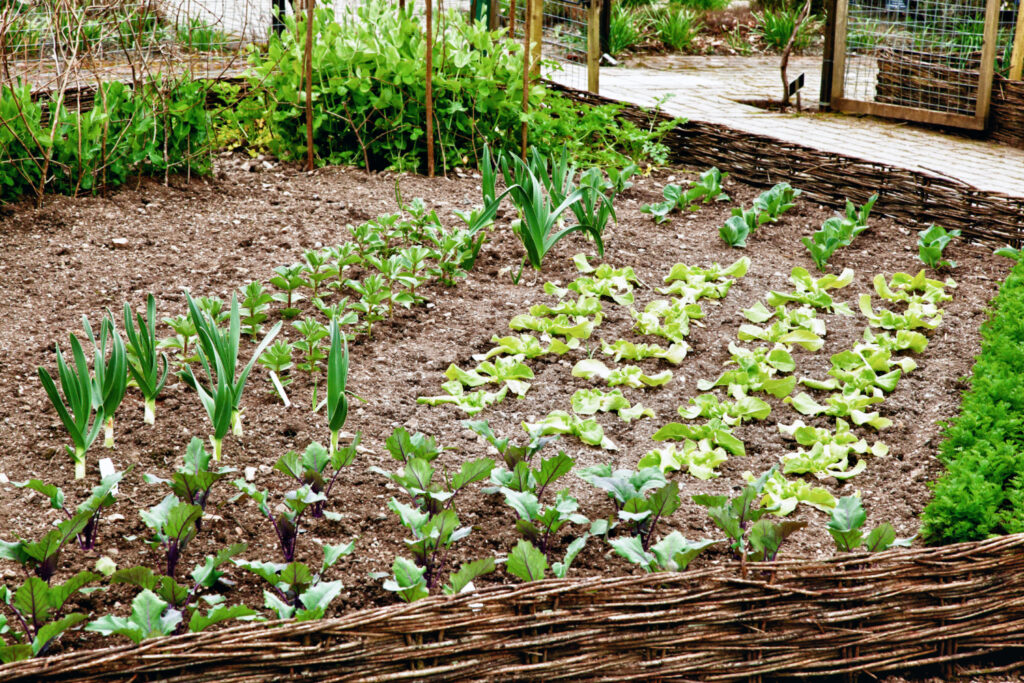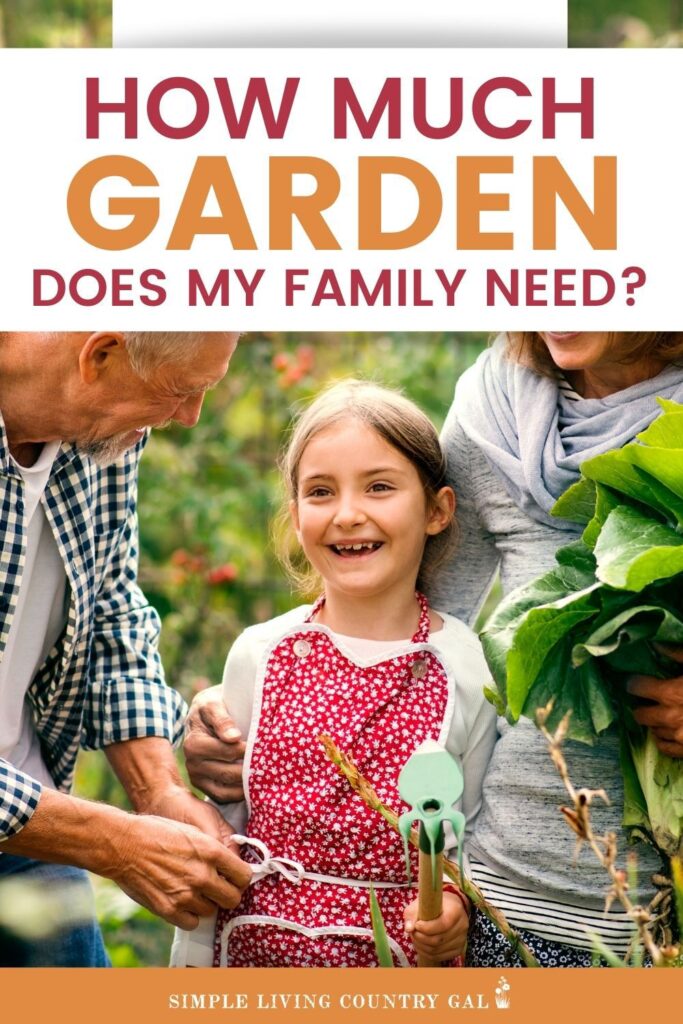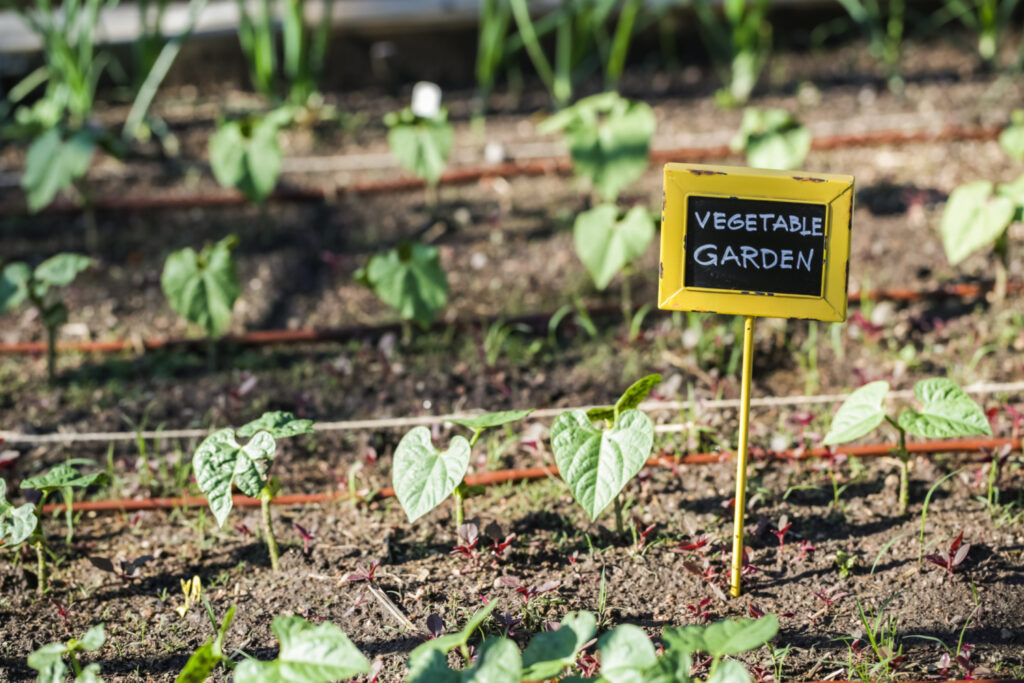How Big Of A Garden Do I Need
Get the help you need to plan a productive year on the homestead! Grab your FREE Homestead Project Planner HERE. Thanks for visiting!
Yes, vegetable garden size really does matter.
I remember the first year I had a garden. I had such big and lofty goals. I wanted it all and I was going to grow it all! Tomatoes, carrots, peppers, radishes, even corn. I wanted everything I could think of to be in my garden that first year. Little did I realize just how much I was biting off.
My first garden was about 30feet by 40feet. Yes, you read that right….FEET.
It was beautiful! So full of fresh green plants and neat long rows. I really love that garden and I would spend time out there every day working to keep things healthy and strong.
Then life happened. Kids, activities, outings, summer gatherings, and before I knew it that garden because a monumental chore that simply got away from me. Weeds took over and my once neat rows were now impossible to find. Luckily, most of the plants made it all the way, well except for my lettuce. Did you know that lettuce can keep growing up? So far up that it will rival any corn stalk if left to their own devices.

But my story doesn't end there. Just as I was relieved to see that my plants actually did create produce for our little family to enjoy I soon realized that my window was a short one and if I didn't hurry I would lose what I worked so hard to plant. Before I knew it, I was thrust into preservation mode and that is where things really got dicey. My eyes were definitely bigger than all our stomachs that first year and lucky for me I had neighbors to help take the excess because I simply could not keep up with it all.
That was an eye-opening year for me but I learned a valuable lesson. You need to know what your family will eat and just how much your family will eat before you put any seeds into the ground.
If you're new to gardening or you've only planted a small garden in the past and you're interested in expanding, it can be a challenge to estimate how big of a garden you'll need for your whole family. Some vegetables will provide a large harvest with just a few plants and others will need a lot of room to grow enough vegetables to feed your family. How do you estimate your vegetable garden size?
There are a few factors that go into determining how big of a garden you'll need. The size of your family, the vegetables you plan to grow, and whether you're  planting year-round or seasonally, how much time you have to preserve your bounty. Yes, these are all questions that need to be considered before you started raking that soil.
planting year-round or seasonally, how much time you have to preserve your bounty. Yes, these are all questions that need to be considered before you started raking that soil.
A good rule of thumb is to plan on 200 square feet of garden space per person. That means an average family of four will need an 800 square foot garden, or a plot that's 20 feet by 40 feet in size. A smaller or larger family can scale up or down from these estimates.
It's also important when considering your vegetable garden size, to note that some crops, like asparagus, Brussels sprouts, melons, and squash, take up more room than most other crops so you'll need more space if you plan to add any of those plants to this year's summer garden.
What to Grow in a Family Garden
Figuring out what you'll grow is an important step to take before laying out your garden. How much room your plants will need can vastly change the size of the garden you plant.
Think about the types of vegetables your family already enjoys, the produce you tend to buy week after week at the grocery store. By including these plants in your garden plans you will, not only save money by growing them yourself you will also gain peace of mind knowing where your family's favorites came from.
SLCG PRO TIP: Don't be afraid to try new vegetables too. When your kids get involved in gardening, they're more likely to eat what they grow. Read: How to Plant a Family Garden
Lastly, think about the climate in your area, what is the weather like? If you live in the south where it doesn't get very cold, you'll probably be able to garden all winter long. But if you live in the north or Midwest, you may only be able to garden a few months out of the year unless you plant in a greenhouse or use cold frames for your garden.
Finally, you will want to keep in mind just how much you plan to keep for the colder months. Do you want to freeze or can some of your harvest for later? If so, you'll want to plan on growing a bit more than what you think you'll eat.
How Much to Grow for My Family
For an average family of four, these are some estimates of what you should plan on planting for various types of vegetables. If your family eats certain vegetables a lot or only every once in a while, you can increase or reduce the number of plants. Knowing how much each plant will produce will help you set the best vegetable garden size for your family.
How much harvest will I get per plant:
Artichokes – 6 plants provide 12 lbs. of harvest – 1-2 plants per person
Asparagus – 18 plants provide 8 lbs. of harvest – 4-5 plants per person
Beets – 60 plants provide 14 lbs. of harvest – 10-15 plants per person
Bell Peppers – 15 plants provide 12 lbs. of harvest – 3-4 plants per person
Broccoli – 22 plants provide 32 lbs. of harvest – 5-6 plants per person
Brussels Sprouts – 22 plants provide 24 lbs. of harvest – 5-6 plants per person
Cabbage – 27 plants provide 60 lbs. of harvest – 6-7 plants per person
Carrots – 48 plants provide 40 lbs. of harvest – 10-12 plants per person
Cauliflower – 24 plants provide 36 lbs. of harvest – 5-6 plants per person
Celery – 41 plants provide 16 lbs. of harvest – 9-10 plants per person
Corn – 94 plants provide 100 lbs. of harvest – 22-24 plants per person
Cucumbers – 14 plants provide 32 lbs. of harvest – 3-4 plants per person
Eggplant – 10 plants provide 16 lbs. of harvest – 2-3 plants per person
Kale – 4 plants provide 4 lbs. for harvest – 1 plant per person
Lettuce – 42 plants provide 24 lbs. of harvest – 10-12 plants per person
Melons – 7 plants provide 24 lbs. of harvest – 1-2 plants per person
Peas – 90 plants provide 12 lbs. of harvest – 20-22 plants per person
Potatoes – 100 plants provide 100 lbs. of harvest – 23-25 plants per person
Spinach – 30 plants provide 12 lbs. of harvest – 7-8 plants per person
Squash – 9 plants provide 24 lbs. of harvest – 2-3 plants per person
Sweet Potatoes – 11 plants provide 12 lbs. of harvest – 2-3 plants per person
Tomatoes – 39 plants provide 96 lbs. of harvest – 9-10 plants per person
If you have little ones who eat small meals, you can downsize the number of plants that you'll need. But if you plan to freeze or can any of your harvest to use when the vegetables are out of season, you'll probably want to grow a little extra. Plan on planting a few extra plants for anything you want to freeze or can.
Your vegetable garden size will vary based on the plants you want to grow and how much of each vegetable you plan to plant. That's why it's important to plan your garden in advance before you start digging.
You can also plan a seasonal garden, growing some vegetables in the warmer months and others in the colder months. This will allow you to benefit from your garden's harvest all year long. You'll find that some vegetables actually grow better in colder temperatures with less sunlight so they're perfect for winter gardening. And using a cold frame will allow your garden to flourish with the help of sunlight while keeping the frost off your plants and protecting them from hungry winter scavengers.
What to Grow to Feed My Family All Year
Warm-weather vegetables to plant include:
- Beans
- Corn
- Cucumbers
- Eggplant
- Melons
- Peppers
- Pumpkin
- Sweet Potatoes
- Summer Squash
- Tomatoes
- Watermelon
- Zucchini
Cool-weather vegetables to plant include:
- Asparagus
- Beets
- Broccoli
- Brussels Sprouts
- Carrots
- Cauliflower
- Kale
- Lettuce
- Onions
- Peas
- Radishes
- Spinach
- Swiss Chard
- Turnips
How to Get the Most from Your Garden Size
There are a few extra things you can do to make the most of your garden so that you can harvest fresh vegetables all year long. Here are some tips for success:
- Rotate Your Garden
When a plant is no longer producing, pull it out and plant something else. Planting warm-weather vegetables for summer growth, then pulling them to plant cold-weather vegetables throughout winter will all you the best harvest. You can also stagger your planting by 2-3 weeks to extend the harvest times. Planting seeds of the same crop at different times will also allow for harvesting at different times. Just staggering your planting by a couple of weeks means you'll have vegetables still in bloom while others are ready to eat, allowing you to get the most from your harvest.
- Give Intercropping a Try
Intercropping is essentially planting crops of various sizes and growth rates together to maximize your space. It's most commonly used in small gardens, but you can use it in a larger garden as well to maximize your harvest. For instance, while your Brussels sprouts are growing and spreading out, you can use the space in between to plant lettuce or radishes for a quick growing crop.
- Keep Up with Harvesting
Harvesting your produce a little early usually allows the plant to yield more produce throughout its life. Keeping up with your harvest will help you get the most of your plants. Once your plants start to produce, pick vegetables every day to every three days for the highest yield.
- Mulch to Reduce Weeds
Weeds can easily invade your garden so keep them at bay by using a layer of mulch around your plants. This will benefit your plants and reduce the amount of work you need to do in order to maintain your garden. READ: How to Mulch your Garden to Stop Weeds from Day One
- Grow Plants that are Suited to Your Area
Growing vegetables suited to your area will give you the highest yield. If your area is prone to sudden changes in temperature, some less hardy plants won't survive. Plant vegetables that are compatible with your temperatures in your area. It's also important to make sure that your garden is placed in an area that will receive plenty of sunlight. Receiving too much or too little light can be damaging to your plants.
- Consider Cold Frames
If you want to garden year-round and continue to harvest your garden through the winter, you may want to consider cold frames. They're easy to make or you can purchase ready-made ones to lay over your plants. It will keep scavengers and frost out while letting in plenty of sunlight to help your plants thrive. READ: How to Grow Vegetables in the Winter
Proper Garden Watering
Watering your garden properly is one of the best ways to ensure success. There are some Do's and Don'ts to follow to properly care for your garden that I want to go over quickly. You can read more here . Yes, watering is really important for your garden plants, especially in the beginning.
DO water in the morning before the sunlight is right overhead. The ground is still cool from the night and the leaves will have plenty of time to dry before night comes again.
DON'T water at night. The soil is warm and will soak up and evaporate too much water. And if the leaves of your plants don't dry before nightfall, they attract fungus and insects.
DO water at a few intervals and for an extended period of time so that the water can be soaked into the soil and reach the roots.
DON'T water lightly, it's harmful to the root system. A quick 10-minute sprinkle every day isn't going to provide enough water.
DO direct the water to the roots for better absorption
DON'T water overhead, soaking the leaves.
DO give your garden about an inch of water every week for maximum benefits. If you're not sure how much that is, set out an empty tuna fish can. When it's full, you're done.
DON'T underwater, it can lead to poor root growth which will, in turn, lead to a low producing plant.
How to Preserve Your Harvest
Now that you have plenty of vegetables and the best-sized garden for your family, what should you do if you have too much? Or, if you want to save warm weather produce to use over the winter? No need to worry, you can easily save your harvest to use later.
Consider freezing or canning to preserve your harvest so that you can use it all year long. Both methods are easy to do and will keep your fresh produce tasty until you're ready to eat it.
Freezing is the easiest way to save your vegetables and it doesn't require any special tools, just some freezer-safe bags. If you plan to freeze for later, dice your vegetables first then lay them out in a single layer on a baking sheet and place the sheet in the freezer for about 30 minutes. Once frozen, portion your vegetables out into freezer-safe bags, label your bags with the type of vegetable and date of freezing, and place them back in the freezer until you're ready to use them. You can also use a food storage system to ensure your produce lasts all winter in your freezer. A great investment for anyone that wants fresh veggies without freezer burn.
Canning is also another option for preserving your vegetables, but it does require special tools and a little knowledge to do it safely. You'll need canning jars that are cleaned, sterilized, and dried. And you'll need to decide how you want to seal your jars; a water bath is usually the easiest method. Before canning, consider using your vegetables to make soups, relishes, jams, and sauces that you can save for ready-made meals later on. A quick dinner with homemade spaghetti sauce made with tomatoes fresh from your garden that you picked months ago; what could be better or easier?
Canning Supplies Quick List
Water canner
Canning jars
Canning jar lifter and misc supplies
A good reliable canning book
Growing a fresh vegetable garden to feed your family will save you money and give you peace of mind about where your produce comes from. Use the estimates provided to determine your vegetable garden size, but consider a slightly larger or smaller garden if you want a larger or smaller harvest based on your family's needs.
Growing your own vegetable garden is also a great way to get your kids involved in an outdoor activity and they'll be more likely to eat vegetables that they've grown themselves. A homegrown vegetable garden is great for the whole family.
How Big Of A Garden Do I Need
Source: https://simplelivingcountrygal.com/vegetable-garden-size/
Posted by: gossforproing.blogspot.com


0 Response to "How Big Of A Garden Do I Need"
Post a Comment